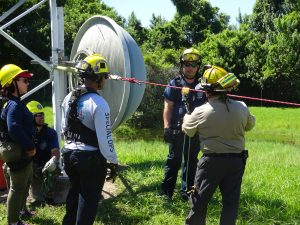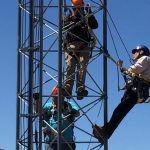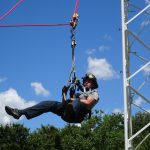Awareness Level

1 Day Course Prerequisite: None
Class Size: No Maximum
Training is compliant to the NFPA 1670 and 1006 as it pertains to Tower Rescue. This one day course covers the overview of types of towers, hazards, ground operations, what you are able to do in the event of a “Tower Rescue” and how you can help.
Learn More
Awareness level
Awareness levels shall be permitted to assist in support functions are a tower rescue operations such as ground support but shall not be deployed onto the tower.
Awareness level shall be responsible for removal retrieval of subjects only in cases where climbing the tower is not required and hazards are limited to potential falls.
Organizations operating at the awareness level for tower rescue incidents shall implement procedures for the following:
- Recognizing the need for tower rescue
- Initiating contact and establishing communications with a subject or subjects were possible
- Initiating the emergency response system for tower rescue
- Recognizing different types and purposes of towers with consideration to the given information
- Performing a retrieval without ascending the structure or tower
- Initiating site control and see management
- Recognizing in identifying the hazards associated with tower emergencies
- Recognizing the limitations of conventional emergency response skills and equipment in various tower environments
- Initiating the collection and recording of information necessary to assist operational personnel on a tower rescue
- Identifying and securing any reporting parties and witnesses
- Establishing familiarity with lockout / tag out procedures
Operations Level
 2 Day Course Prerequisite “Awareness”
2 Day Course Prerequisite “Awareness”
Class Size Limit: 10
Training is compliant to the NFPA 1670 and 1006 as it pertains to Tower Rescue. This two day course takes the next step in training to a level of actual climbing safety and rescue techniques.
Learn More
Operations level
The organization operating at this level shall be responsible for the development and training of a tower rescue team that is trained, equipped, and available to respond to tower emergencies of a type and complexity where all of the following are true:
- A climbing a ladder, integrated tower safety system, or both, is present, and rescuers can access the subject using available PPE and tower climbing techniques constant with the requirements set forth within this chapter.
- The tower is not structurally compromised
- The site is not effected by hazards other than those related to working at height
- The climb path is not obstructed
- A rescue pre-plan exists for that particular tower site and preparation / planning has been performed with the tower owner / operator
- This subject can be reached and evacuation performed in accordance with the preplanned in such a manner so as to avoid additional hazards, entanglement, or restrictions to the rescue effort
- The tower can accommodate two or more rescuers in addition to the victim
- All hazards in and around the tower have been identified, isolated, and controlled
- The operation is feasible using the equipment or systems with which the organization has been trained
- The height of the tower does not exceed 300 feet
Organizations operating at the operations level shall ensure that at least four individuals who are trained and capable of ensuring and all operations level response are available to respond to a tower incident at any given time, and shall develop and implement procedures for the following:
- Sizing up the existing and potential conditions at a tower incident sites
- Protecting personnel from hazards on and around the tower environment
- Ensuring that personnel are capable of managing the physical and psychological challenges that affect rescuers ascending and climbing towers
- Performing ongoing assessment of conditions affecting the tower rescue operation
- Requesting and interfacing with specialize resources applicable to tower safety
- Placing a team of two rescuers on a tower where existing ladder or step bolts and climbing protection is present, using accepted tower safety methods and procedures consistent with requirements
- Performing the following basic rescue techniques with two rescuers on a tower:
- Releasing a subject from fall protection
- Lowering a subject vertically down an unobstructed path
- Performing a rescue of a subject or methods require up to a 15° deviation from plum and can be performed with the tagline
- Performing selection, care, and use of personal tower climbing equipment
- Procuring the necessary tower site information, including owner and lessor information, site plan, and specific hazard information
- Modifying actions and urgency as applicable to a rescue vs. a recovery
- Acquiring information on current and forecast weather, including temperature, precipitation, lightning potential, and winds
- Recognizing, identifying, and utilizing typical fall protection and safety hardware and software used by tower climbers
- Recognizing the team’s limitations regarding accessing a subject, evacuating a subject, or both
- Recognizing and using engineered anchor points for the rescue operation
- Developing of and adhering to contingency plans when weather or other factors make operations level response ineffective or dangerous to rescuers
Each member of the operations level tower rescue organization who might be responsible for ascending a tower for rescue shall demonstrate competence ease in the press falls and use of the following:
- Job hazard analysis used on tower sites
- 100% fall protection
- Tower anchorages
- Use of energy absorbing lanyards
- Use of work positioning lanyards
- Self-retracting lifelines
- Vertical lifelines for Fall-arrest
- Ladder climbing safety systems
- Horizontal lifelines
- Use of Pre-Climb checklist
- Tower ladder / peg climbing techniques
- Transferring between a ladder and the tower structure
- Selection and use of appropriate rescue equipment and techniques for a given tower rescue situation
Technician Level

3 Day Course Prerequisite “Awareness” and “Operations”
Class Size Limit 8
Organizations operating at the technician level shall be capable of performing and supervising all aspects of any tower rescue operation with which the organization can become involved.
Learn More
Technician level
When organizations operating at the technician level for tower rescue emergencies shall meet all of the requirements of this chapter plus the requirements of section five the technician level rope rescue
The organization operating at this level shall be responsible for the development of a tower rescue team of at least four individuals who are trained, equipped, and available to respond to tower emergencies of a type and complexity that requires a technician level organization, including where any one or more of the following conditions exist:
- A climbing ladder or climbing pegs are not present
- An integrated tower safety system is not present
- The tower is structurally compromised
- The site is affected by hazards other than those directly related to the tower or fall protection
- The climbing path is obstructed
- A rescue pre-plan does not exist, has been compromised, is infeasible, and / or is not sufficient to resolve the problem at hand
- The tower cannot accommodate more than one rescuer in addition to the victim
- Use of standard subject packaging devices, systems, and / or procedures is infeasible
- The capabilities of operations level skills are exceeded
- The height of the tower exceeds 300 feet
Organizations operating at the technician level for tower rescue emergencies shall be capable of developing and implementing procedures for the following:
- Evaluating hazards in establishing a climbing path for an unfamiliar tower
- Isolating and controlling electrical hazards on an unfamiliar tower
- Identifying and controlling EMF / RF hazards of an unfamiliar tower
- Accessing and rescuing from a tower using non-standard anchorages
- Planning and implementing response for tower rescues on unfamiliar towers where ascent of the tower is required
- Placing at least one rescuer on the tower without the benefit of a ladder, step bolts, or integrated fall protection while maintaining 100% fall protection at all times
- Performing basic rescue techniques, including at least the following, with only one rescuer on the tower:
- Releasing a subject from common types of fall protection including a vertical lifeline (cable), vertical lifeline (rope), fall arrest lanyard and SRL
- Lowering a subject vertically down and obstructed path
- Performing a rescue were the subject must been moved horizontally as well as vertically
Each member of the technician level tower rescue organization who might be responsible for ascending a tower for rescue shall demonstrate competency in all of the capabilities outlined for operations level plus the following:
- Use of energy absorbing Lanyards
- Horizontal lifelines
- Use of a Pre-Climb checklist
- Tower structure climbing techniques
- Transfer between different parts of the structures, and between the structure and the rescue system
- Selection and use of rescue equipment and techniques for a tower rescue situation that has not been pre-planed
Prerequisites:
- 1 Day – Awareness Level = None
- 2 Day – Operations Level = Awareness
- 3 Day – Technician Level = Awareness and Operations
Class Size Limit:
- 1 Day – Awareness = no limit
- 2 Day – Operations = Class Size :.. Call us for options and large class discounts!
- 3 Day – Technician = Class Size :.. Call us for options and large class discounts!
(Contact us for details on signing up larger classes)
Call us at 717-966-9922 for a training quote.
As the standards pertain to:
